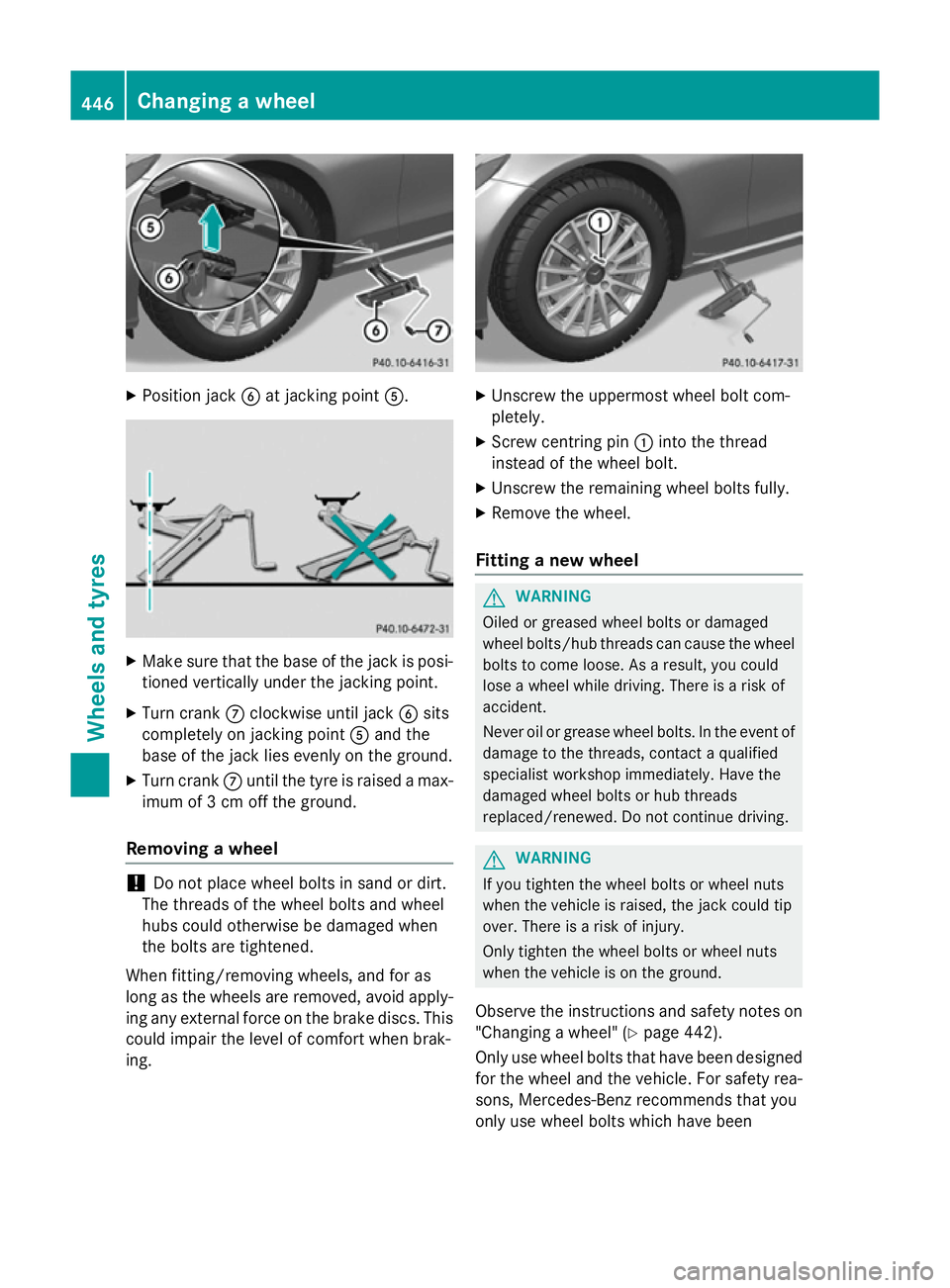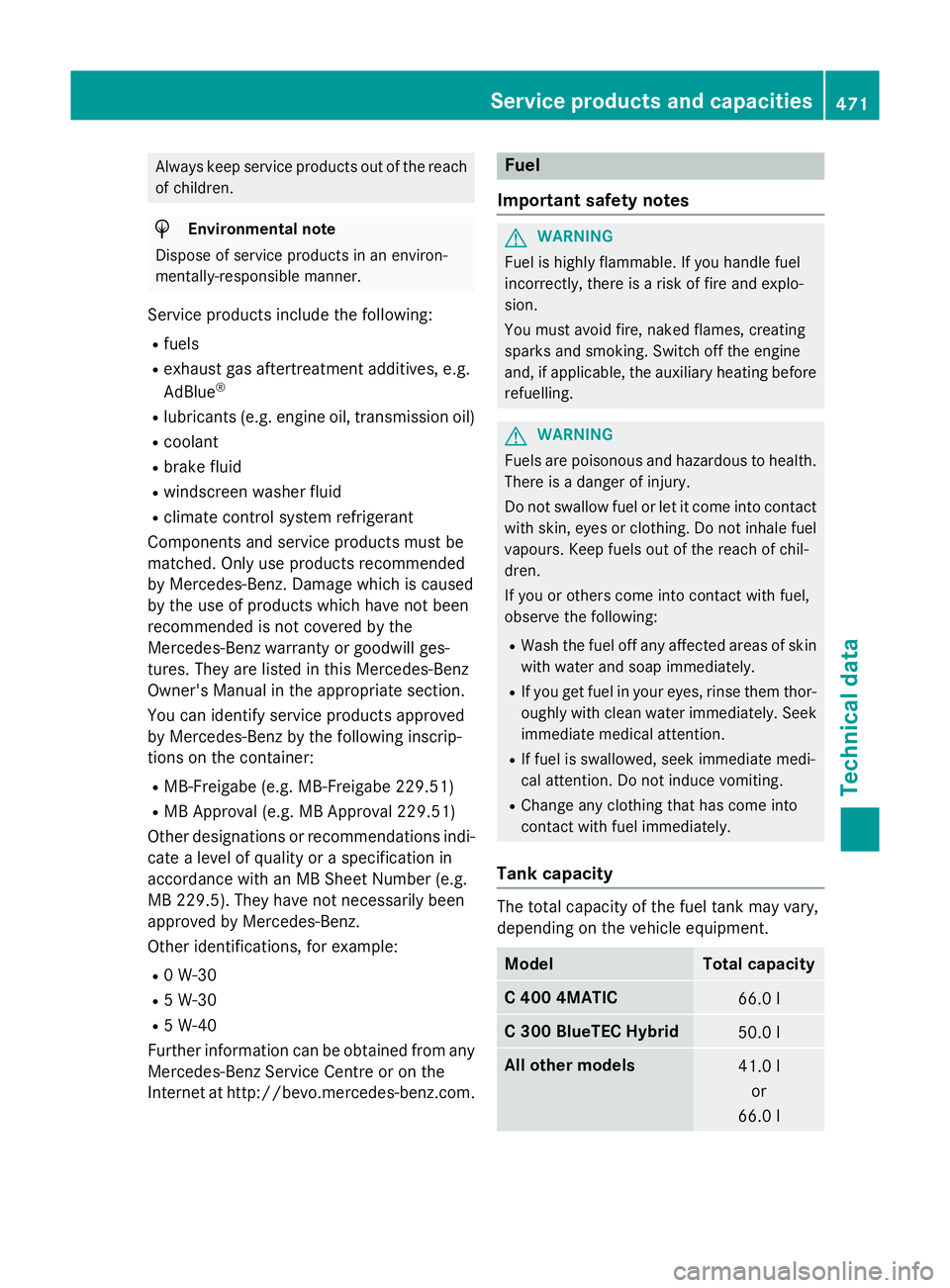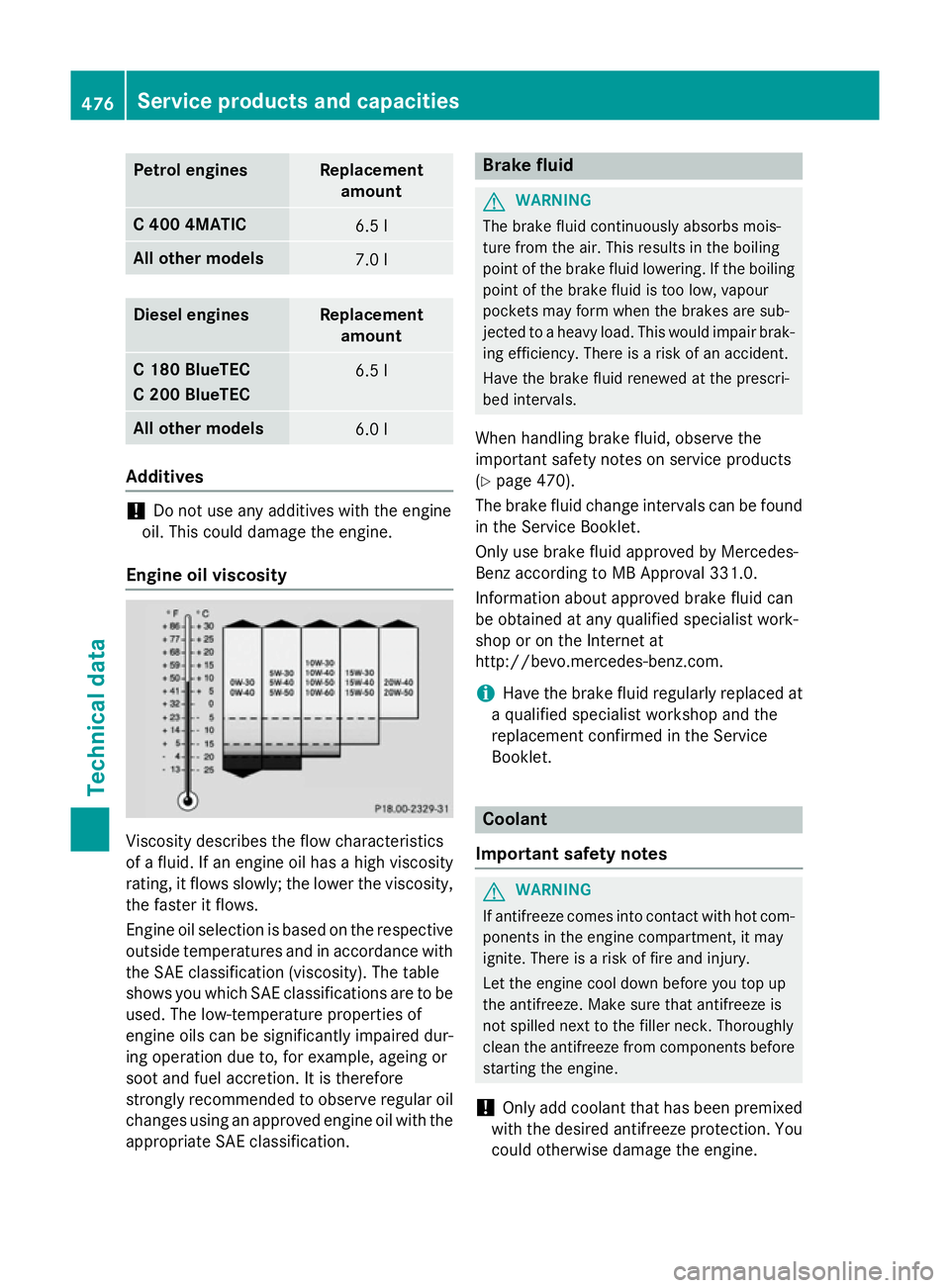Page 449 of 489

X
Position jack Bat jacking point A. X
Make sure that the base of the jack is posi-
tioned vertically under the jacking point.
X Turn crank Cclockwise until jack Bsits
completely on jacking point Aand the
base of the jack lies evenly on the ground.
X Turn crank Cuntil the tyre is raised a max-
imum of 3 cm off the ground.
Removing a wheel !
Do not place wheel bolts in sand or dirt.
The threads of the wheel bolts and wheel
hubs could otherwise be damaged when
the bolts are tightened.
When fitting/removing wheels, and for as
long as the wheels are removed, avoid apply- ing any external force on the brake discs. This
could impair the level of comfort when brak-
ing. X
Unscrew the uppermost wheel bolt com-
pletely.
X Screw centring pin :into the thread
instead of the wheel bolt.
X Unscrew the remaining wheel bolts fully.
X Remove the wheel.
Fitting a new wheel G
WARNING
Oiled or greased wheel bolts or damaged
wheel bolts/hub threads can cause the wheel bolts to come loose. As a result, you could
lose a wheel while driving. There is a risk of
accident.
Never oil or grease wheel bolts. In the event ofdamage to the threads, contact a qualified
specialist workshop immediately. Have the
damaged wheel bolts or hub threads
replaced/renewed. Do not continue driving. G
WARNING
If you tighten the wheel bolts or wheel nuts
when the vehicle is raised, the jack could tip
over. There is a risk of injury.
Only tighten the wheel bolts or wheel nuts
when the vehicle is on the ground.
Observe the instructions and safety notes on "Changing a wheel" (Y page 442).
Only use wheel bolts that have been designed
for the wheel and the vehicle. For safety rea-
sons, Mercedes-Benz recommends that you
only use wheel bolts which have been 446
Changing a wheelWheels and tyres
Page 474 of 489

Always keep service products out of the reach
of children. H
Environmental note
Dispose of service products in an environ-
mentally-responsible manner.
Service products include the following:
R fuels
R exhaust gas aftertreatment additives, e.g.
AdBlue ®
R lubricants (e.g. engine oil, transmission oil)
R coolant
R brake fluid
R windscreen washer fluid
R climate control system refrigerant
Components and service products must be
matched. Only use products recommended
by Mercedes-Benz. Damage which is caused
by the use of products which have not been
recommended is not covered by the
Mercedes-Benz warranty or goodwill ges-
tures. They are listed in this Mercedes-Benz
Owner's Manual in the appropriate section.
You can identify service products approved
by Mercedes-Benz by the following inscrip-
tions on the container:
R MB-Freigabe (e.g. MB-Freigabe 229.51)
R MB Approval (e.g. MB Approval 229.51)
Other designations or recommendations indi- cate a level of quality or a specification in
accordance with an MB Sheet Number (e.g.
MB 229.5). They have not necessarily been
approved by Mercedes-Benz.
Other identifications, for example:
R 0 W-30
R 5 W-30
R 5 W-40
Further information can be obtained from any
Mercedes-Benz Service Centre or on the
Internet at http://bevo.mercedes-benz.com. Fuel
Important safety notes G
WARNING
Fuel is highly flammable. If you handle fuel
incorrectly, there is a risk of fire and explo-
sion.
You must avoid fire, naked flames, creating
sparks and smoking. Switch off the engine
and, if applicable, the auxiliary heating before refuelling. G
WARNING
Fuels are poisonous and hazardous to health. There is a danger of injury.
Do not swallow fuel or let it come into contact
with skin, eyes or clothing. Do not inhale fuel
vapours. Keep fuels out of the reach of chil-
dren.
If you or others come into contact with fuel,
observe the following:
R Wash the fuel off any affected areas of skin
with water and soap immediately.
R If you get fuel in your eyes, rinse them thor-
oughly with clean water immediately. Seek immediate medical attention.
R If fuel is swallowed, seek immediate medi-
cal attention. Do not induce vomiting.
R Change any clothing that has come into
contact with fuel immediately.
Tank capacity The total capacity of the fuel tank may vary,
depending on the vehicle equipment.
Model Total capacity
C 400 4MATIC
66.0 l
C 300 BlueTEC Hybrid
50.0 l
All other models
41.0 l
or
66.0 l Service products and capacities
471Technical data Z
Page 479 of 489

Petrol engines Replacement
amount C 400 4MATIC
6.5 l
All other models
7.0 l
Diesel engines Replacement
amount C 180 BlueTEC
C 200 BlueTEC
6.5 l
All other models
6.0 l
Additives
!
Do not use any additives with the engine
oil. This could damage the engine.
Engine oil viscosity Viscosity describes the flow characteristics
of a fluid. If an engine oil has a high viscosity
rating, it flows slowly; the lower the viscosity,
the faster it flows.
Engine oil selection is based on the respective outside temperatures and in accordance with
the SAE classification (viscosity). The table
shows you which SAE classifications are to be
used. The low-temperature properties of
engine oils can be significantly impaired dur-
ing operation due to, for example, ageing or
soot and fuel accretion. It is therefore
strongly recommended to observe regular oil changes using an approved engine oil with the
appropriate SAE classification. Brake fluid
G
WARNING
The brake fluid continuously absorbs mois-
ture from the air. This results in the boiling
point of the brake fluid lowering. If the boiling
point of the brake fluid is too low, vapour
pockets may form when the brakes are sub-
jected to a heavy load. This would impair brak- ing efficiency. There is a risk of an accident.
Have the brake fluid renewed at the prescri-
bed intervals.
When handling brake fluid, observe the
important safety notes on service products
(Y page 470).
The brake fluid change intervals can be found in the Service Booklet.
Only use brake fluid approved by Mercedes-
Benz according to MB Approval 331.0.
Information about approved brake fluid can
be obtained at any qualified specialist work-
shop or on the Internet at
http://bevo.mercedes-benz.com.
i Have the brake fluid regularly replaced at
a qualified specialist workshop and the
replacement confirmed in the Service
Booklet. Coolant
Important safety notes G
WARNING
If antifreeze comes into contact with hot com- ponents in the engine compartment, it may
ignite. There is a risk of fire and injury.
Let the engine cool down before you top up
the antifreeze. Make sure that antifreeze is
not spilled next to the filler neck. Thoroughly
clean the antifreeze from components before
starting the engine.
! Only add coolant that has been premixed
with the desired antifreeze protection. You
could otherwise damage the engine. 476
Service products and capacitiesTechnical data
Page 483 of 489
Trailer loads
Permissible trailer load, braked (at a minimum gradient-climbing capability of 8%
from a standstill). Missing values were not available at the time of going to print.
Manual transmission Automatic transmission
C 180
1600 kg 1800 kg
C 180 BlueTEC
1600 kg 1800 kg
C 200
1600 kg 1800 kg
C 200 BlueTEC
1600 kg 1800 kg
C 220 BlueTEC
1800 kg 1800 kg
Automatic transmission
C 250
1800 kg
C 250 BlueTEC
1800 kg
C 250 BlueTEC 4MATIC
1800 kg
C 300 BlueTEC Hybrid
C 400 4MATIC
1800 kg
Permissible trailer load, braked (at a minimum gradient-climbing capability of 12%
from a standstill). Missing values were not available at the time of going to print.
Manual transmission Automatic transmission
C 180
1600 kg 1800 kg
C 180 BlueTEC
1600 kg 1800 kg
C 200
1600 kg 1800 kg
C 200 BlueTEC
1600 kg 1800 kg
C 220 BlueTEC
1800 kg 1800 kg
Automatic transmission
C 250
1800 kg
C 250 BlueTEC
1800 kg
C 250 BlueTEC 4MATIC
1800 kg480
Trailer tow hitchTechnical data
Page 484 of 489
Automatic transmission
C 300 BlueTEC Hybrid
C 400 4MATIC
1800 kg
Permissible trailer load, unbraked
Manual transmission Automatic transmission
C 180
730 kg 745 kg
C 180 BlueTEC
750 kg 750 kg
C 200
745 kg 750 kg
C 200 BlueTEC
750 kg 750 kg
C 220 BlueTEC
750 kg 750 kg
Automatic transmission
C 250
750 kg
C 250 BlueTEC
750 kg
C 250 BlueTEC 4MATIC
750 kg
C 300 BlueTEC Hybrid
750 kg
C 400 4MATIC
750 kg
Maximum drawbar noseweight
!
Use a drawbar noseweight as close as possible to the maximum permissible noseweight.
Do not use a noseweight of less than 50kg, otherwise the trailer may come loose.
Note that the payload and the rear axle load are reduced by the actual payload.
The drawbar noseweight is not included in the trailer load. Manual transmission Automatic transmission
C 180
75 kg 75 kg
C 180 BlueTEC
75 kg 75 kg
C 200
75 kg 75 kg
C 200 BlueTEC
75 kg 75 kg
C 220 BlueTEC
75 kg 75 kgTrailer tow hitch
481Technical data Z